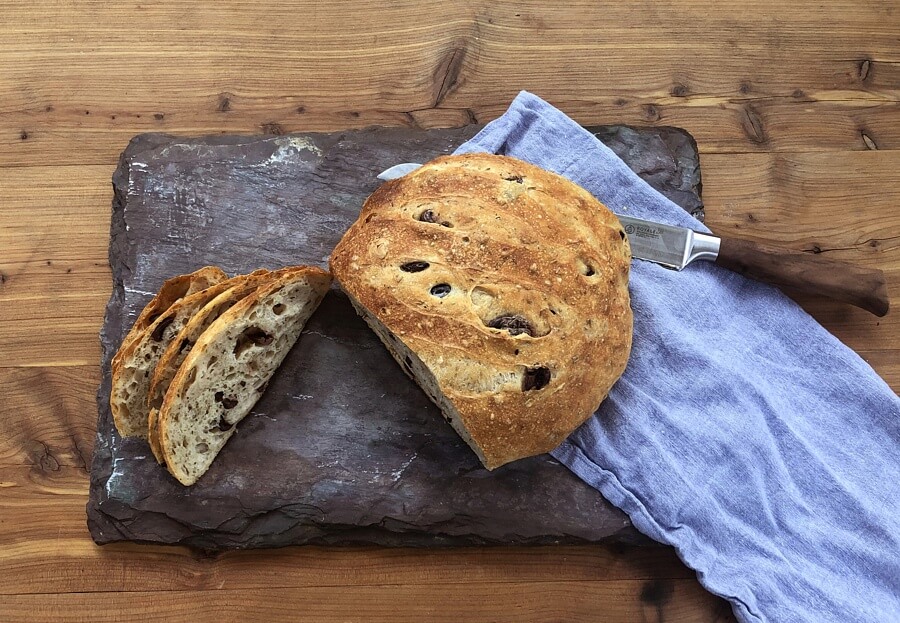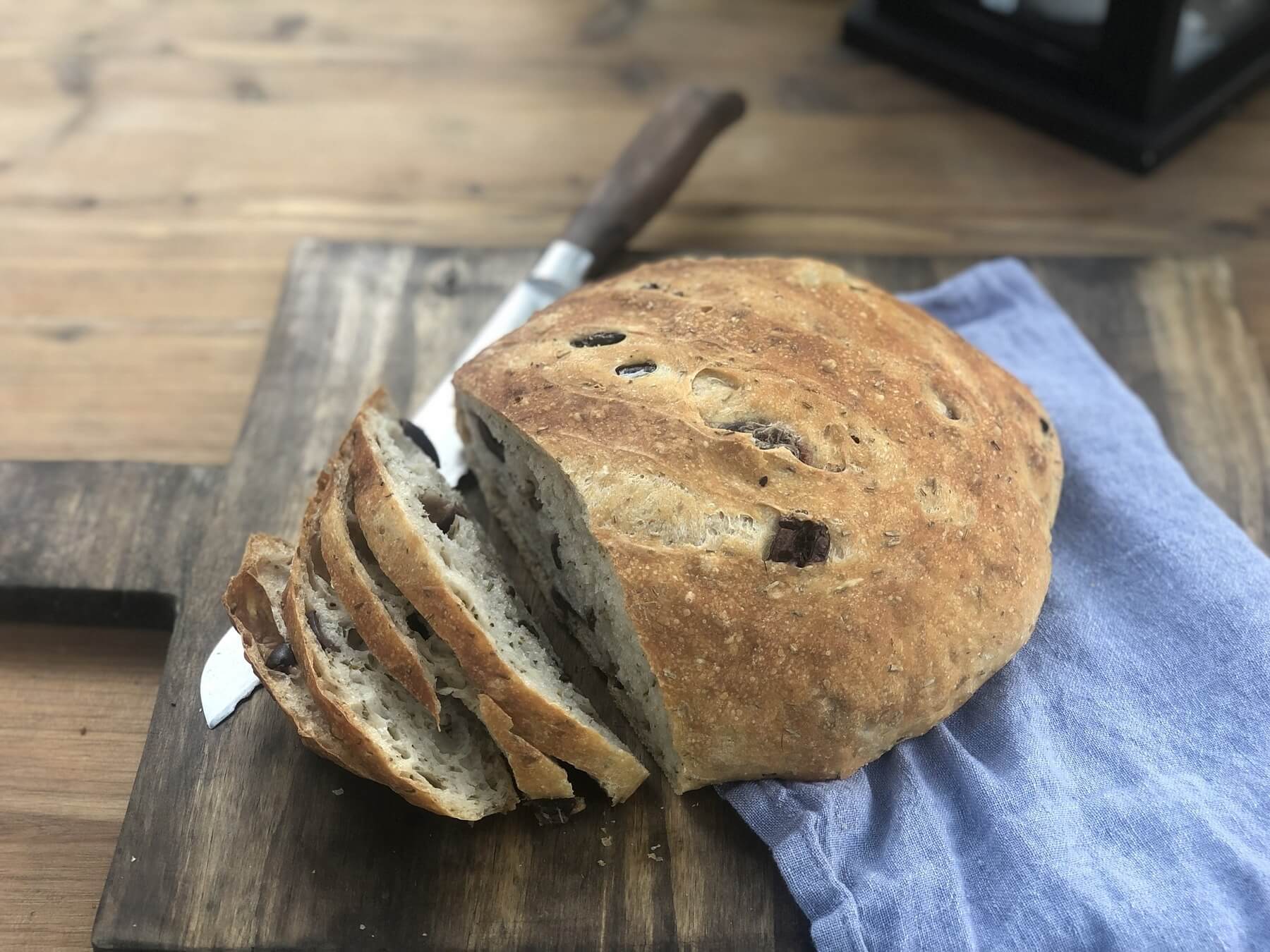I’m a little hesitant to give away this secret. For years, I’ve received compliments galore whenever I bring my fresh-baked homemade bread to a gathering. People seriously cannot believe that bread this good can be easily baked at home without exhaustive kneading, expensive equipment or special skills. But it can, and I’m going to let you in on the secret.
Be warned, you may need to practice making this homemade bread recipe a few times in order to get the feel for how the dough should look and what the consistency should be when it’s just right. Ovens, home temperature and humidity levels all impact the results as well, so it may take several times until you perfect it. As long as you don’t leave the salt out, the mistake loaves will still be amazingly delicious even if they turn out more like flat focaccia than a round boule.

You don’t need a bread maker or a special baking vessel — I bake my homemade bread side by side on a cookie sheet lined with parchment paper. This recipe is endlessly adaptable as well! Don’t like olives? No problem, just use rosemary alone. Craving something with a bit more texture? Add a tablespoon each of flax, sesame and poppy seeds into the dough, and dust the top of the bread with the seed mixture before baking. Personally, I’m going to test a version with cinnamon and sugar in it next. I will likely halve the amount of salt I use but keep the recipe the same otherwise.

A few tips:
- Is the dough too sticky in your first round of mixing? Simply add 1/4 cup of bread flour until it’s a more cohesive consistency. This recipe is very forgiving, unlike most baking projects.
- Similarly, is the dough too dry? Just add 2 Tbsp. of water at a time until the flour is fully mixed into the dough.
- Oven temperatures vary widely, no matter what temperature you have it set to on the dial. You’ll know the bread is ready when the bottom is slightly browned and lifts easily from the parchment paper, and the loaf sounds hollow when you tap the top of the bread.
- To keep the crust of the bread crunchy, don’t store it in a plastic bag on the first day. Leave it sitting out on the counter. If you’re lucky enough to have any leftover over after the first day, store the remaining sliced pieces in a zip-lock bag in the fridge to keep it fresh for as long as possible.
- You can freeze the bread, too. Bake it as normal, slice it and slide it into a gallon-size freezer bag. Just toast each piece from frozen when you want it, and it’s nearly as good as fresh-baked.

Homemade Bread: The Easiest Recipe Ever

Rosemary Olive Bread
Ingredients
- 1 jar sliced Kalamata olives
- About 12 sprigs fresh rosemary stems removed and chopped OR two tablespoons dried rosemary
- 5.5 cups King Arthur unbleached bread flour must be bread flour!
- 2 Tbsp. kosher salt do NOT use regular table salt
- 3.5 cups hot water not boiling, just hot water from the tap
- 2 Tbsp. active dry yeast or two packets of instant yeast. RedStar brand recommended.
- 1 tsp. of sugar
Instructions
- Pour the yeast into a medium-size bowl. Add the hot tap water to the bowl slowly. Sprinkle the sugar on top of the water (this helps activate the yeast). Let sit for 5-7 minutes until it starts to bubble.
- Add the bread flour to a large mixing bowl. Next, add the 2 tbsp. (yes, two FULL tablespoons!) of kosher salt and mix. Then add the chopped rosemary and the sliced Kalamata olives. It's okay if some olive juice gets in there, sometimes I even add it on purpose. Mix the dry ingredients together.
- Add the activated water/yeast to the flour mixture. Stir with a wooden spoon until a loose dough forms. If it's too dry and not coming together, add a tiny bit of warm water at a time until it comes together. If it's too wet and super sticky, add 1/4 cup of flour until it comes together into a dough that is pliable (it can still be sticky).
- Cover the bowl with loose plastic wrap and then a tea towel. Set somewhere room temp or warmer for 3 hours to rise. If you want, you can leave this out overnight, but leave it out at least 2-3 hours until the dough rises to almost fill the bowl.
- Wet your hands to prevent sticking, and then pick the dough up out of the bowl and knead it gently. If the dough is still sticky at this point and does not form a smooth dough ball, add 1/4 cup bread flour until you reach the desired consistency. Then, place the dough back into the bowl for a second rise in the fridge. Leave the dough in the fridge overnight and until 2-3 hours before you're ready to bake the dough. It can live in the fridge for up to two full days before baking.
- Pull the dough out of the fridge at least two hours before you want to bake the dough (3.5 hours at least before serving). It will have risen again, so take the dough in your hands to knead lightly again. Then separate the dough into two equal parts, form into balls, and place on a parchment paper-lined cookie sheet (no need for semolina or cooking spray to prevent sticking — it won't stick to parchment paper). The dough can be touching or not touching, it doesn't matter. Let the dough rise on the cookie sheets for at least two hours. Thirty minutes before baking, preheat the oven to 500 degrees F, and place a dish/pan with a bunch of ice cubes on the rack below where the bread will be going to create steam. When the dough has risen and the oven is preheated, score the tops of the loaves so steam can escape while baking and quickly slide the bread in the oven as to not let out too much steam. Lower the heat to 450 degrees F, and bake the bread for 30 minutes exactly on the middle to lower rack. If it starts to burn on top, slide some parchment paper on top of it.
- Once 30 minutes is up, pull the bread out and let it rest for at least 30 minutes before slicing as it's still cooking.
- Eat at least half a loaf while it's fresh and warm!
Nutrition
Find more amazing recipes in our archives. Click HERE!



















